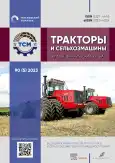The observer of traction electromagnetic torque at the shaft of a traction electric motor
- Authors: Klimov A.V.1,2
-
Affiliations:
- KAMAZ Innovation Center
- Moscow Polytechnic University
- Issue: Vol 90, No 5 (2023)
- Pages: 423-432
- Section: New machines and equipment
- URL: https://journal-vniispk.ru/0321-4443/article/view/249965
- DOI: https://doi.org/10.17816/0321-4443-472138
- ID: 249965
Cite item
Full Text
Abstract
BACKGROUND: Currently, the requirements to energy efficiency of transport vehicles are more and more tightened due to service cost reduction. Energy efficiency is the most relevant for them as it directly influences on the key feature — maximum mileage. Therefore it is necessary to control electric motors in a way to ensure maximal surface grip coefficient excluding propulsors’ slipping, as well as to establish operation modes of motors and switching between the modes to the one having the maximal efficiency. In this case, for effective control, it is necessary to define electromagnetic torque at the shaft of an electric motor and resistance torque at wheels rapidly for generating corresponding control and correcting exposures.
AIMS: Development of the theoretical basis and the law of estimation the electromagnetic torque at the shaft of a traction electric motor of transport vehicles for the sake of efficient control of traction electric drive and its diagnostics.
METHODS: Simulation of the observer of the electromagnetic torque at the shaft of a traction electric motor was carried out in the MATLAB/Simulink software package.
RESULTS: The article provides with theoretical basis of formatting the law of optimal estimation of the electromagnetic torque at the shaft of a traction electric motor of transport vehicles for the sake of efficient control of traction electric drive, its diagnostics, as well as the results of simulation the law of estimation of the electromagnetic torque at the shaft of a traction electric motor obtained in the MATLAB/Simulink.
CONCLUSIONS: Practical value of the study lies in ability of using the proposed observer for development of control system and diagnostics of transport vehicles.
Keywords
Full Text
##article.viewOnOriginalSite##About the authors
Alexander V. Klimov
KAMAZ Innovation Center; Moscow Polytechnic University
Author for correspondence.
Email: klimmanen@mail.ru
ORCID iD: 0000-0002-5351-3622
SPIN-code: 7637-3104
Scopus Author ID: 57218166154
Cand. Sci. (Tech.), Head of the Electric Vehicles Service, Associate Professor at the Prospective Engineering School of Electric Transport
Russian Federation, 38 Bolshaya Semenovskaya street, 107023 Moscow; MoscowReferences
- Andryushchenko VA. Theory of automatic control systems: Textbook. Leningrad: Izd-vo Leningradskogo universiteta; 1990. (in Russ).
- Aliev FA, Larin VB, Naumenko KI, et al. Optimization of linear time-invariant control systems. Kyiv: Naukova dumka, 1978. (in Russ).
- Ivanov VA, Faldin FV. Theory of optimal automatic control systems. Moscow: Nauka; 1981. (in Russ).
- Keller A, Sergeevsky YuN. Direct measurement of torque in an electric drive. In: Proceedings of the VIII International (XIX All-Russian) Conference on Automated Electric Drive AEP-2014. Saransk, October 07–09, 2014. Saransk; 2014:58–62. (in Russ).
- Smolin V, Topolskaya I, Gladyshev S. Energy Method for Torque Control of a Synchronous Traction Motor. SAE Technical papers. 2018:2018-01-0766. doi: 10.4271/2018-01-0766
- Smolin VI, Topolskaya IG, Volovich GI. The energy method for monitoring the instantaneous state and the information of a synchronous motor control variables. In: 2016 2nd International Conference on Industrial Engineering, Applications and Manufacturing (ICIEAM). Chelyabinsk: IEEE; 2016. doi: 10.1109/ICIEAM.2016.7911509
- Shulga RN. On the issue of determining the electromagnetic torque on the shaft of a traction asynchronous motor. Elektrooborudovanie: ekspluatatsiya i remont. 2022;7. (in Russ).
- Anuchin AS. Electric drive control systems: a textbook for universities. Moscow: Izd dom MEI; 2013. (in Russ).
- Gorelov VV, Zhileikin MM, Lovtsov AN, et al. Control law with the function of active safety systems for electromechanical transmissions of multi-axle wheeled vehicles. Izvestiya VUZov. Mashinostroenie. 2013;9:56–66. (in Russ).
- Afanasyev BA, Belousov BN, Zheglov LF, et al. Design of all-wheel drive wheeled vehicles: Textbook for universities; In 3 volumes. Moscow: MGTU im NE Baumana; 2008;3. (in Russ).
- Litvinov AS, Farobin YaE. Car: Theory of performance properties: a textbook for universities. Moscow: Mashinostroenie; 1989. (in Russ).
Supplementary files












